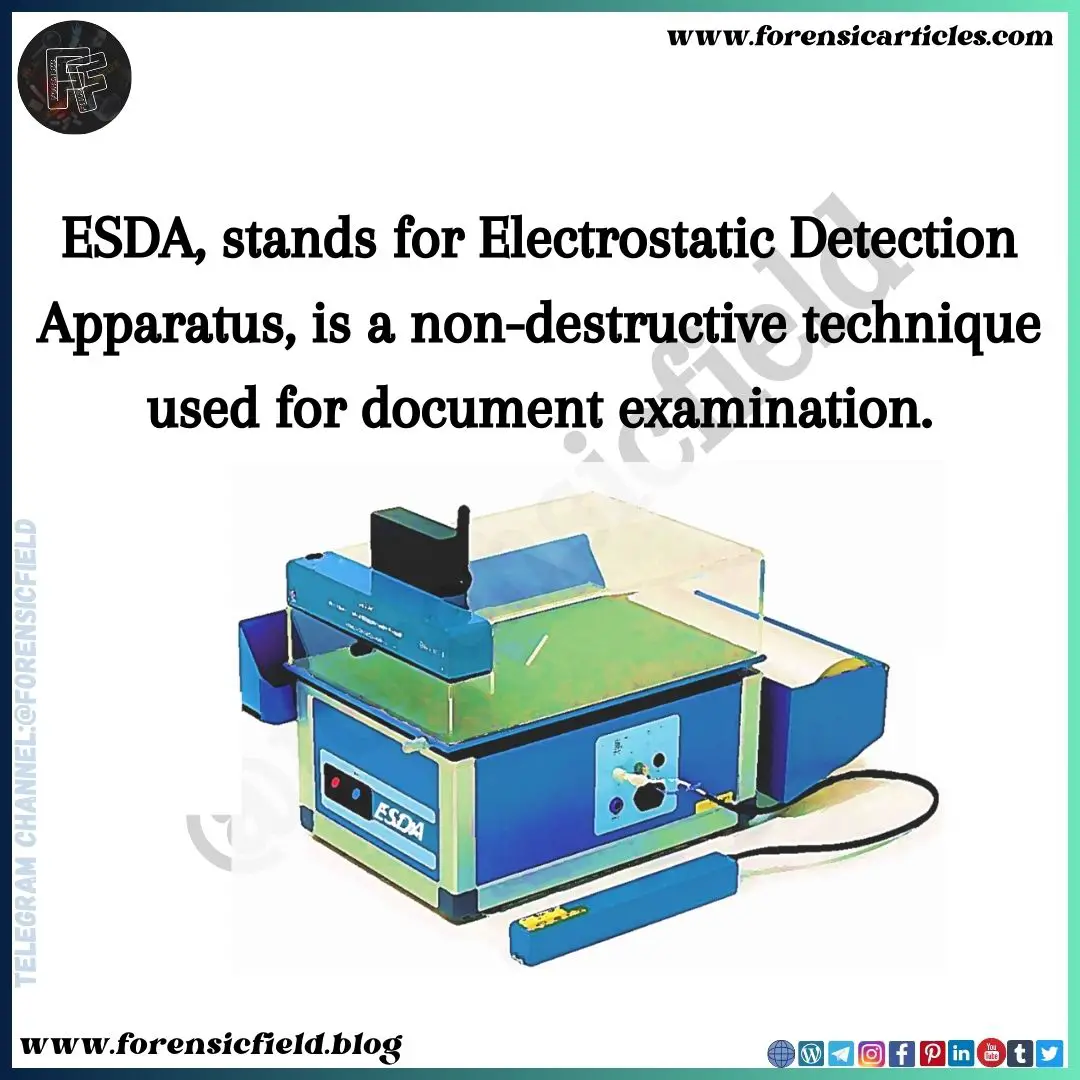[ad_1]
ESDA, stands for Electrostatic Detection Apparatus, is a non-destructive approach used for doc examination.

Introduction
ESDA stands for Electrostatic Detection Equipment. The instrument is utilized within the questioned doc examination to detect any indentations or impressions that will exist on paper. Foster and Freeman are the producers of ESDA. The approach described is very delicate and may detect indentations on paper. ESDA refers to a tool used for detecting electrostatic fees. The electrostatic detection equipment (ESDA) is a forensic doc examination approach routinely employed by examiners. This technique permits the detection of imprints on a doc, just like invisible carbon paper, left by gadgets that will have been written on a sheet positioned on high of the examined doc. Within the context of authorized instances, its functions embrace revealing conflicting proof and uncovering potential forgeries.
Additionally Learn: Devices Utilized in Ink Evaluation
Working of ESDA
ESDA is a specialised gear consisting of a number of parts, together with an ESDA machine, a skinny base for holding the doc, a cellophane (plastic movie) that’s secured onto the doc utilizing vacuum know-how, an electrostatic cost system, and a toner. The toner used on this system is similar to the toner utilized in electro-photographic printing gadgets.
ESDA makes use of the tactic of stretching a Mylar movie, just like Clingfilm, over the doc below examination. The Mylar movie is charged electrostatically utilizing a “wand” that consists of an extended, skinny stick or rod containing a high-quality wire charged to 7 kV. In areas the place the paper is clean, the charging tends to be evenly distributed. The electrostatic cost in areas the place the fibers of the paper have been disrupted because of contact with different paper, leading to indentations, is distinct from the encompassing background cost. The method described leads to the formation of a latent picture. The latent picture could be visualized by making use of black toner to the floor of the Mylar. The toner adheres to the areas the place the electrostatic cost accumulates, particularly within the indentations. The result is a visible illustration that includes a background with a gray toner shade and darker toner markings in areas with depressed impressions. The picture is made everlasting by way of a course of known as “carry,” which entails putting a transparent “sticky-backed plastic” over the toner to create a set clear picture.
There are three strategies for making use of toner onto the Mylar movie:
- The primary technique entails cascading tiny glass beads coated with toner over the floor.
- The second technique entails puffing an aerosol of toner powder over the floor.
- The third technique entails utilizing a tool just like a powder puff to use the toner.
The presence of the paper between the grounded plate and the Mylar charging movie creates a capacitor-like impact. The capacitance is set by the various compensation of the paper. The web page believed to have indentations is roofed with a cellophane materials. This materials is then pressed firmly in opposition to the paper utilizing a vacuum created by pulling air by way of a porous bronze plate. The aim of this motion is to safe the doc and cellophane masking to the plate. The presence of a cellophane masking serves the aim of safeguarding the unique doc from potential hurt or injury. The doc and cellophane endure a repeated excessive voltage static cost.
The standard of ESDA lifts is influenced by quite a few variables. The components to contemplate in analyzing the impressions left on paper embrace the kind of paper, the kind of pen or stylus used, the variety of sheets of paper between the writing and the sheet holding the impressions, and the humidity on the time of impressions.
Benefits of ESDA
There are two benefits related to electrostatic detection. ESDA is non-destructive. The protecting mylar floor reveals the indentations, that are then sealed by masking the cellophane with pressure-sensitive adhesive plastic. Second, the unique doc is just not broken at any level all through the process. The Second benefit is that ESDA is so delicate that it might simply detect and permit for the visualization of indentations as much as 7 sheets under the web page the place the unique writing was made that might be not possible to detect with another approach.
Disadvantages of ESDA
The drawback is that it’s unsuitable for inspecting free paper, equivalent to newspapers, or very shiny supplies, equivalent to journal covers. ESDA impressions might be utterly destroyed if the doc comes into contact with liquid.
References
- Allen, M. (2015). Foundations of forensic doc evaluation: principle and observe. New Jersey: John Wiley & Sons.
- Baier, P. E. (1983). ‘Software of Experimental Variables to the Use of the Electrostatic Detection Equipment’. Journal of Forensic Sciences, 28(4), pp. 901-910.
- Barton, B. (1989). ‘The usage of an electrostatic detection equipment to show the matching of torn paper edges’. Journal of the Forensic Science Society, 29(1), pp. 35-38.
- Cheng, Ok., Chao, C., Jeng, B., & Lee, S. (1998). ‘A brand new technique of figuring out writing sequence with the laser scanning confocal microscope’. Journal of Forensic Science, 43(2), pp. 348-352.
- Daéid, N., Hayes, okay., & Allen, m. (2008). ‘Investigations into components affecting the cascade developer utilized in ESDA—A evaluate’. Forensic science worldwide, 181(1-3), pp. 1-9.
- D’Andrea, F., Mazzella, W., Khanmy, A., & Margot, P. (1996). ‘Results of the Relative Humidity and Temperature on the Effectivity of the ESDA (Electrostatic Detection Equipment) Course of’. Worldwide Journal of Forensic Doc Examiners, 2(3), pp. 209-213.
- Ellen, D. (2006). Scientific Examination of Paperwork: Strategies and Strategies (thirded.). Boca Raton, USA: Taylor and Francis Group.
- Fatima, F. (2019). ‘Handwriting Evaluation from Particular person Profiling to Forensic Questioned Doc Examination’. Worldwide Journal for Digital Crime Investigation, 3(1), pp. 13.
- Foster, D., & Morantz, D. (1979). ‘An electrostatic imaging approach for the detection of indented impressions in paperwork’. Forensic Science Worldwide, pp. 51-54.
Associated
[ad_2]


